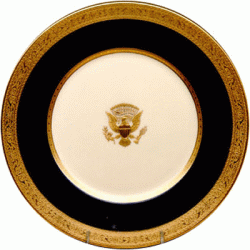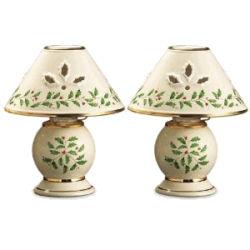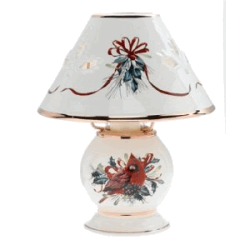Lenox Lamps: Ceramic and Fine Bone China Lamps
Lenox lamps bring the elegance and sophistication of ceramic art to your lighting design.
Lenox lamps are distinctive among current lamps. Unlike most lamps, which have been developed to match various antique or contemporary furniture styles, they have been developed from the tradition of ceramic art. Their bases are made from fine bone china or other ceramics and often include detailed moldings that highlight the power and strength of their materials.
As a result, Lenox lamps can have a little difficulty fitting into overall interior design. They are not designed to match so much as to stand out as decorative objects in their own right. Used properly, however, this is not a problem. The trick is to treat them as though they are ornaments rather than as furniture. This both integrates them into an overall design and provides them with the attention that their careful design deserves.
History
The company now referred to simply as “Lenox” was originally founded as “Lenox’s Ceramic Art Company” in 1889. Its name should give some sense of the company’s original focus. Walter Scott Lenox founded the company to supply all manner of ceramic art. Now, the company provides almost half of the china in the United States, but it still carries on this tradition of providing quality ceramic art.

The first ever official presidential china was commissioned by President Woodrow Wilson from Lenox’s Ceramic Art Company.
In time, Lenox became one of the most respected ceramic companies in the United States, and their brand is especially popular among couples choosing china for their wedding registries. When a new president is elected, he (or often the First Lady) will choose a set of fine bone china to serve as his official place settings. Lenox china has been chosen five times, by Presidents Woodrow Wilson, Franklin D. Roosevelt, Ronald Reagan, Bill Clinton and George W. Bush.
As electric lighting was developed, Lenox’s Ceramic Art Company found that its mission of providing high quality, American ceramic art was well-suited to the task of making electric lamps. Lenox provided a unique style of lamp, providing works of ceramic art in their own right.
Types
Almost all Lenox lamps are table lamps, simply because a ceramic lamp that is much larger would be too fragile (not to mention expensive). Nonetheless, there is a wide variety available Lenox table lamps available, suited to many different design preferences.

Lenox produces lamps for tea lights and has many lamps dedicated to holiday (and especially winter and Christmas) themes. These lamps are available at Amazon.
The first type of lamp are vase-shaped lamps. The stems of these lamps are usually wave patterns of some kind, from very thin, undulating patterns to rounder, almost globular pattern. In fact, it is because of the flexibility of ceramics that Lenox light fixtures are able to have such variation. Contrary to popular belief, fine bone china is actually a very strong ceramic material. These lamps are more similar to traditional, non-ceramic lamps, but Lenox light fixtures tend to have patterns designed to stand out rather than blend in.
The second type of lamp is the statuary lamp. These lamps are often statues that are lit from the inside, rather than statues that have a bulb standing above the statue, as you might expect. These lamps tend to be much more expensive than the symmetrical lamps, and they serve as works of art in their own right. Antique Lenox statuary lamps can easily cost over a thousand dollars per lamp.
Light Quality
Lenox lamps provide fairly standard light quality for lamps, but there are some things that you should consider when choosing one. The primary issue is the material out of which the bases of the lamps are made. Ceramics are reflective and not especially translucent, which affects the quality of the light.

Between the holes in the shade and the reflectivity of the base, this Lenox lamp will provide different light patterns than you might be use to. This model is available at Amazon.
The reason the material of the base is important is that china is what is called a “semi-reflective” material. In other words, some of the light that shines onto the base will actually reflect in various directions around the base of the lamp. Since this reflection is only off of a semi-reflective surface, this reflection will be diffuse, producing areas of light with soft edges. If the stem and base of the lamp has some sort of molding, this reflection may be even less uniform.
Statuary lights where the light is placed inside the statue (or for any lamp that has a full ceramic shade) will produce a quite different quality of light than you may be used to from a lamp. In fact, all of the light produced from such a lamp will be diffuse and directionless, producing very weak shadows. This can actually be excellent for lighting design. One of the hardest things to produce when lighting a room is diffuse light that comes from below. Lenox statuary lamps do this by providing lights where all of the light must go through ceramics.
Placement
The trickiest aspect of using Lenox lamps is that they are almost too attractive, especially statuary lamps. Usually, lamps are placed in such a way as to blend in with their surroundings, not stand out. Decorative objects are often placed under lamps, but the lamps themselves are not especially decorative. Because of their origins in ceramic art rather than in furniture making, Lenox lamps are designed to attract the eye, not to simply blend in.
The trick with Lenox lamps is to actually keep them away from other decorative objects. Because they capture the eye themselves, if they are placed near any other decorative objects, the area will look cluttered. Instead, place them on a table where the table serves as a showpiece for the lamp itself. The lamps are certainly attractive enough that they can serve this role.
A nice advantage of Lenox lamps is that, unlike other decorative objects, they provide their own source of illumination. Normally, if you set aside a table for illumination, you would need to use some sort of accent lighting to highlight your work of art. Lenox lamps can simplify your lighting design by removing the need for these extra light sources.
Putting It All Together
Lenox lamps provide an attractive fusion of ceramic art and lamp design:
- They include semi-reflective surfaces, so they produce a mixture of beamed and diffuse light.
- They come in a variety of styles, including undulating styles and statuary.
- Because they are so attractive in their own right, they need to be appropriately isolated, or else the areas around them may become cluttered.
Lenox lamps can be an attractive feature in most home’s lighting design.
